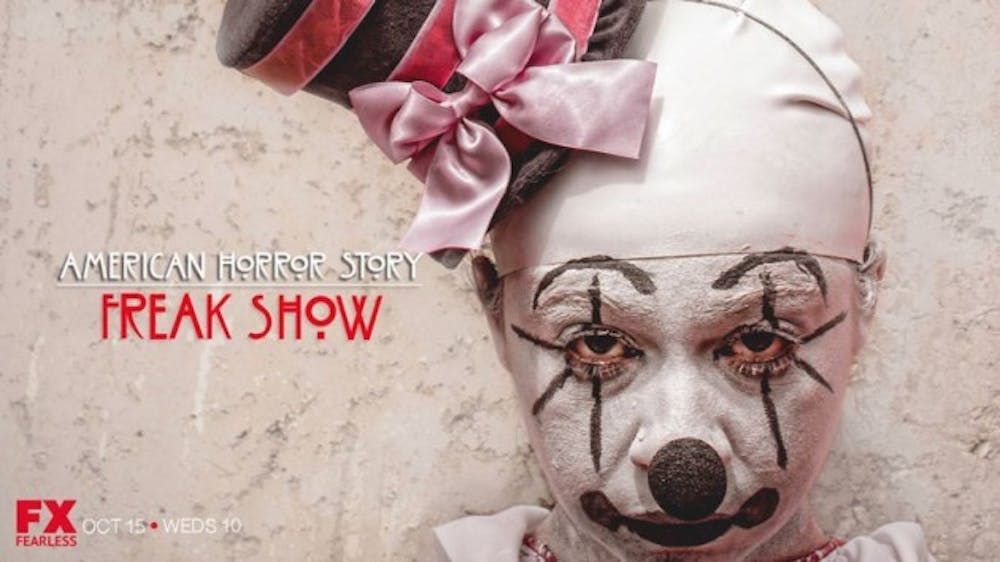Show: “American Horror Story: Freak Show”
Network: FX
Airing: Wednesdays at 10 p.m.
As Halloween is upon us several things are certain: First, you must be sick of pumpkins and the color orange. Second, the Hallmark Channel will already be playing Christmas movies. Third, you’ll spend days looking for the perfect costume only to throw something together at the last minute. Fourth, and most importantly, we are (trick or) treated to a new season in the perennial horror series, “American Horror Story.”
This season takes place midway at the Freak Show. Set in the early ’50s in Jupiter, Florida, “Freakshow” follows a type of entertainment that is slowly falling out of vogue following the advent of television.
Carnival owner Elsa Mars (Jessica Lange, In Secret) insists on the relevancy of her sideshow and seeks out a new pair of misfits to headline her carnival. She is confident that she has found her newest act in a pair of conjoined twins, one of whom doesn’t want to be attached to her sister anymore.
To make matters worse, there is a serial killer clown running rampant whose motives aren’t yet apparent. His terrifying, permanent smile haunts viewers as the clown bounces from house to house, slaying his victims with juggling bats.
The cast of the Freak Show includes recurring award-winning actors from the show’s previous incarnations in the first episodes of the season.
Oscar winner Kathy Bates (Boychoir) as Ethel Darling, the bearded lady, is the highlight of these characters. She is so convincing in this role that you’ll forget the beard is fake. Thankfully, Ryan Murphy, the show’s creator, recognizes Bates’ talent and gives her a more prominent role than she had last season. Dramatic revelations in the third episode allow Bates to show off her talents.
Her son, Jimmy, is played by Evan Peters (Safelight). He suffers from a disease that has deformed his hands into lobster claws. The suave young man despises his place in the show, often covering his hands with gloves. He doesn’t see the difference between freaks and the average person.
Michael Chiklis and Angela Bassett are latecomers to the proceedings and round out the supporting cast as the strongman and the three-breasted performer, respectively – resulting in brilliant casting choices that give the clichéd plotlines their freshness. Murphy ensures that each actor is perfectly matched to his or her character.
Jessica Lange, screened as Elsa Mars, stands out even with the cast is full of seasoned actors. She plays the same character each season: A sinister, oversexed, antagonist who yearns to be a famous star. This year is no different, but her decision to add an accent provides another layer to the character she portrays.
Murphy developed a series that pushes the boundaries of cable television. He’s made horror an accessible genre, which television hasn’t experienced since “The Twilight Zone.” Fans watch this genre because of the mystery, plot twists and oddity of the shows.
Few people watch television shows to focus on the photography or camera techniques, but Murphy has created a TV show that masquerades as a film. Never has regular television looked so much like a Hollywood production. The episodes are beautifully shot with images that conjure depression and despair using ripped canvas tents, dirty and dull hues and overgrown dried grass.
The camerawork forces viewers to notice the techniques he uses. Murphy splits the screen while showing the conjoined twins’ point of view, allowing the otherwise attached pair to demonstrate their variance in thought. This creates a disorienting effect, and allows viewers to visualize the difference between the girls. More inventive camerawork, occurring early in episode three, pays homage to the 1919 silent horror classic, “The Cabinet of Doctor Caligari.” He produces images that replicate those from the original film by filming in black and white through an overexposed pinhole lens.
This season’s focus on freaks may sound offensive to some as if Murphy is mocking these individuals – he isn’t. Instead, he shows the ways in which these “freaks” are persecuted and the stigmas associated with the misfits. Early in the third episode, emotions run high between members of the show – Murphy’s ability to create an attachment between the audience to the characters he creates, as well as the characters to one another, is remarkable.
The first two episodes feels too conventional and predictable, relying more on violence than it has in the past. Murphy sacrifices plot for character development in early episodes, which pays off by episode three with a faster moving plot that is both dark and en(gross)ing.
Although this doesn’t seem like it is going to be the best entry of the series, it still is one of the best offerings on television. The Freak Show is so satisfying that you won’t want to leave … or maybe you just won’t be able to.
email: arts@ubspectrum.com





